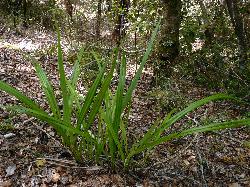- Taxon
- Gallery
- = Dianella reflexa Colenso, Trans. & Proc. New Zealand Inst. 27: 397-398 (1895)
- = Dianella intermedia var. norfolkensis F.Br. (1930)
Plant us. of several lfy fans together, but lateral rhizomes sts carrying young shoots 10 cm. or more from the parent. Stem ± woody, c. 5 mm. diam., lower internodes us. very short, occ. to 15 cm. long. Lvs distichous, equitant, (15)–25–60–(100) × 1–1.5 cm.; sheath often reddish, open at base, narrowed above into a strongly keeled region where the two halves are almost completely fused; lamina of tough texture but not rigid, glossy above, the abaxial surface dull and showing ∞ fine veins; margins revolute on drying and, like the keel, minutely and ± caducously scabrid, especially towards the tip. Peduncle ± flattened, us. with 2 long basal internodes, bracts ± sheath-like. Panicle us. overtopping lvs, broad and very open, the branchlets diverging at narrow angles and all but the lowest bracts very small. Pedicels 1.5–4 cm. long, 3–4 in a group, filiform, not strongly curved. Fls greenish white and inconspicuous; outer tepals c. 3.2–4.5 × 1.5–1.7 mm., the veins, us. 5, occupying most of the width, tip cucullate; inner tepals wider, the veins 3, occ. 5, close together and flanked by wide translucent white margins, tip emarginate. Staminal filaments c. 3 mm. long, the upper ½–⅓ swollen into a ± globose, yellow, papillose struma; anther dehiscing by a slit. Ovary c. 1.5 × 1 mm., sessile; ovules 2 per locule, attached towards top of cavity. Fr. c. 6.5–17 × 6.5–10 mm., globose to oblong, grey-white and dull to strong violet-blue and glossy, the pericarp spongy. Seeds us. < 6, ± quadrate to elliptic in outline with hardened funicle, black, very glossy and smooth. 2n = 16.
[From: Moore and Edgar (1970) Flora of New Zealand. Volume 2.]
Flowering: Nov.–Dec.; Fruiting: Dec.–Mar.




